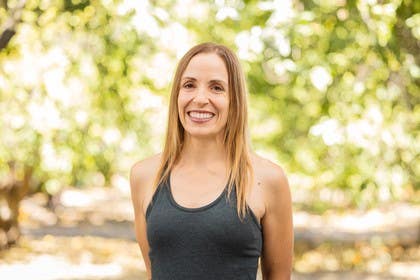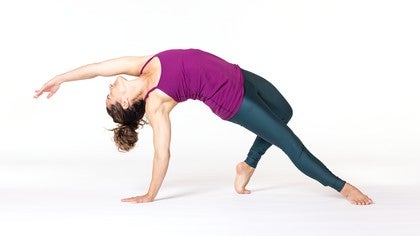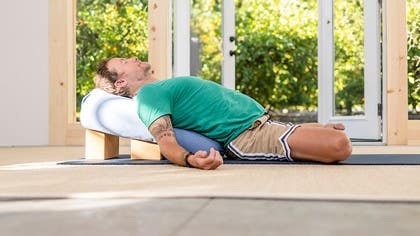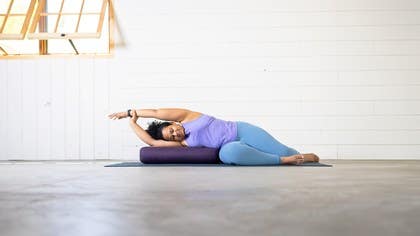
Yoga and Physical Therapy: How to Practice with Injuries
Yoga is purported to heal ailments of all types—from stiffness in the body to chaos in the mind—and scientific research increasingly backs up such claims. Most of us have some sort of pain, be it physical or mental, that lures us onto our mats. If you’ve had any success with yoga as a healing modality, you may know its magic.
Enduring an injury, or nursing a new one, can make us even hungrier for the yoga magic. We turn to our yoga practice, but sometimes find it now aggravates our condition. We modify our practice by trying a new teacher, exploring a new style of yoga, or stop practicing altogether, for fear that yoga is making us worse. Our mood plummets as we lose not only the physical, but also the psychological benefits of our yoga practice. The poorer our outlook, the worse we feel, and a not-so-healing cycle ensues. We wonder, "How can we get our yoga back?"
Having taught yoga for two decades with much of that time looking through the lens of physical therapy, I will share what works for me. I'd encourage you to keep yoga close by, as it can be a great ally in navigating and healing an injury.
Physical Effects
Joints are designed for movement, and over time, we tend to overuse some—hello, osteoarthritis, vertebral disc issues, and other soft tissue injuries—and underuse others, which leads to mobility deficits, muscle weakness, and even osteoporosis. Unlike other forms of exercise, yoga addresses movement with emphasis on the full range of motion at each joint. Even if we sit, stand, and walk most of the time, a yoga practice maintains mobility throughout the body. In fact, yoga evolved to support a wide variety of movements related to the nomadic hunter-gatherer lifestyle. With yoga, strain comes off injured areas and also prevents injury down the line.
Mental-Emotional Ease
With injury, we find ourselves in the unknown. Familiar movement patterns aren’t working anymore. We enter a period of time for re-learning how to move in ways that, we hope, will make us better. This process takes time, and progress often comes in spurts. We do our best to cultivate patience, but new territory brings up feelings of uncertainty and anxiety. We feel uneasy and, on some level, afraid.
This fear reaction comes with a cascade of physiological reactions that evolved long ago. Stress response patterns developed to help us survive threats to our very existence—predators and the hardships of nomadic living reinforced responses that aren’t so useful in modern life, namely fighting, fleeing, and freezing, which also lead to a ramp up of stress hormones such as cortisol. This can play out in many ways. Some people get angry at the injured part and push harder (fight), some ignore the pain signals and become numb to their injury (flee), and some go into bedrest mode (freeze). Though each of these responses is adaptive in its own right, none is a preferred strategy for healing injuries and can even interfere with the process.
Luckily, yoga also developed eons ago, and perhaps it’s no coincidence that the practices are an antidote to the stress response. Slowing down helps us rise to a mountaintop view from where we witness our default strategy and realize we can intervene. We ease up on pushing, ignoring, and hiding to allow a more compassionate dialogue with our pain with willingness to untangle its mysteries. Focusing on mindful, calm breathing reverses the fight-flight-freeze response, slowing our heart rate and setting off a cascade of stress-reducing pathways so we can return to physiologic homeostasis. Our body lets go of being in overdrive, stress hormone levels drop, and there’s time and space to heal.
The Relationship Between the Two
The relationship between the physical and mental-emotional aspects of yoga contains the real nuts and bolts for learning how to practice for injury treatment and prevention. In The Yoga Sutras of Patanjali (2.46), Sthiram Sukham Asanam says that the poses exist as both stability and ease. The concept advises us to approach the yoga poses with a balance of effort and relaxation.
Let’s unravel this concept in light of injury. We need to move to heal—that’s the effort. But what’s the right type and amount of movement? We are sometimes not aware that the pain has begun until it’s full-fledged, and at that point, the damage has already been done.
Working with Your Edge and Finding Ease within the Effort
From the world of physical therapy, there are very few instances where going into pain or increasing symptom severity is useful. If there is actual pain, it’s best to back off. Work up to the edge of where pain would begin and then either stay there or change the pose.
Where exactly is that "edge"? It’s such a fine line, as it requires slowing down to feel it coming. Here is where listening to your intuition and dropping into the reflective mindset of ease is the guide. When we slow down, get quiet, and listen, we create the circumstances needed to hear and heed the warning signals from the body. The messages come very softly like the whispers of a breeze. "Hmm, what’s that sensation?" It feels different and not necessarily good. We notice we are holding our breath or clenching our teeth or shrugging our shoulders. This is your stopping point. Hooray! Ease has helped you hear the subtle warning signals from the body. It’s worth celebrating because this is how we prevent injury and also move safely to promote healing.
So where can you start? You can rein in a little effort and stay in the pose, or come out altogether and move to a different pose, but not to push further. And so it goes in the next pose and the next. Through ease, we can find a safe way to move with practice, so that we can joyfully participate in all the wonderful ways the body can move. We can listen to our body as the teacher of when we might be close to our edge of effort. In this way, we learn to move mindfully so that the body can heal itself.
Understanding the relationship between physical effort and mental ease empowers us to practice yoga under any circumstance. Rather than ignoring the body’s natural warning signals, we come to welcome them, knowing that backing off a little now and then will set the stage for an uninterrupted, sustained yoga practice for years to come. Happy healing!
Comments
No comments yet. Be the first!

















You need to be a subscriber to post a comment.
Please Log In or Create an Account to start your free trial.